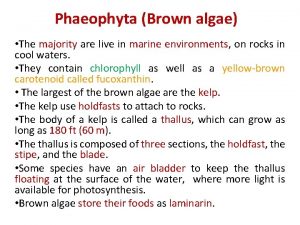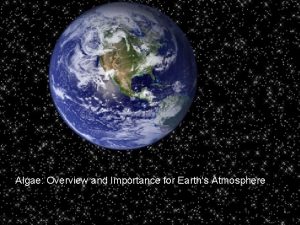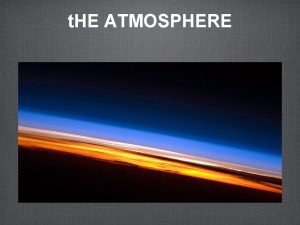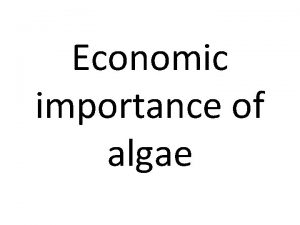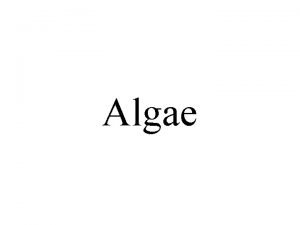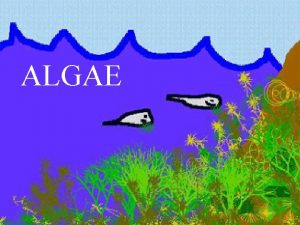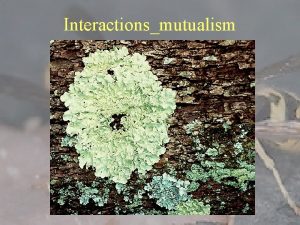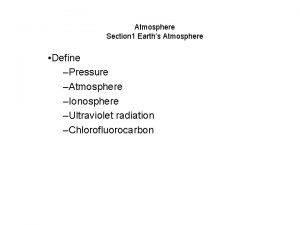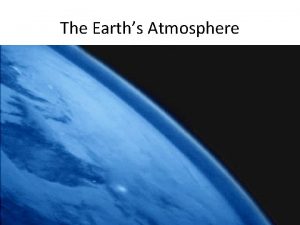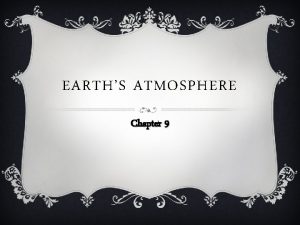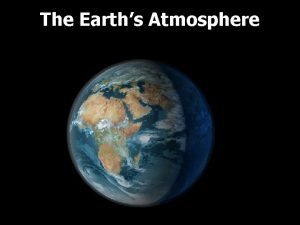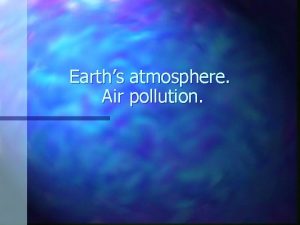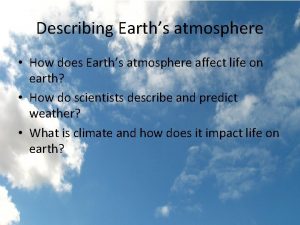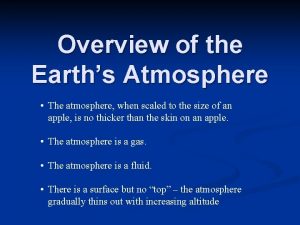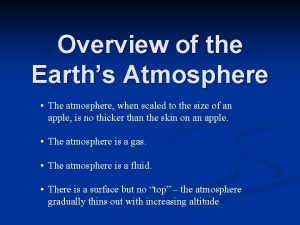Algae Overview and Importance for Earths Atmosphere Earths




























- Slides: 28

Algae: Overview and Importance for Earth’s Atmosphere

Earth’s Atmosphere: Not Much of It Mass Atmosphere = 5. 2 x 1018 kg Mass Oceans = 1. 4 x 1021 kg Mass Earth = 6. 0 x 1024 kg Live Biomass = 1 x 1015 kg Carbon Dioxide = 3 x 1015 kg Trunover Time for carbon dioxide = 5 years in atmosphere, centuries in oceans

Carbon dioxide cycles between low values in summer and higher values in winter in the Northern Hemisphere due to seasonal differences in photosynthesis. Annual input from fossil fuels and deforestation: 3 x 1013 kg carbon dioxide. Half accumulates in the atmosphere, rest is absorbed in oceans, leading to acidification. Pre-industrial carbon dioxide level was 280 ppm, now 380 ppm.

Early Earth Atmosphere: No Oxygen Lots of Carbon Dioxide, Methane, Water Vapor, Hydrogen

Cyanobacteria and Oxygenic Photosynthesis About 3 Billion Years Ago. Water is the electro donor. CO 2 + H 2 O CH 2 O + O 2

Oxygenic photosynthesis is complicated. It requires two photosystems and is thought to have arisen only once in the course of evolution.

Modern Stromatolites Fossil Stromatolite (2. 5 Billion Years Old) Banded Iron Formation Oxygen Was A Poison to Early Life Forms on Earth. Took about 1 billion years before oceans and atmosphere were fully oxygenated

Oxygen in the air allowed the evolution of eucaryotes and aerobic respiration, finally leading to the world’s life forms present today.

Oxygen also produced the ozone shield which protects water in the upper atmosphere from boiling away as hydrogen Ozone in the upper atmosphere (derived from O 2) protects against the splitting H 2 O to H and OH, with H escaping to space. Earth has lost about 25% of its water while water is nearly all gone on Venus and Mars.

Greenhouse Gasses: Water Vapor Carbon Dioxide* Methane* Nitrous Oxide* *Increasing Due To Human Activity

1500 Ma 60 Ma Evolution of the modern algae orders.

600 Ma to present – evolution of animal kingdom

SNOWBALL EARTH 1 st - 2200 MYA 2 nd – 850 MYA

Plate tectonics provides a resupply of carbon dioxide to the atmosphere

50 MYA Diatoms and Grasses Reduce Carbon Dioxide to Very Low Levels Diatoms Grasses

Evolution and impacts of algae on the atmosphere continue today…

In this course we emphasize the ecology and biology of the algae rather than the taxonomy. Main groups we will cover: Cyanobacteria (blue-green algae) Green Algae Red Algae Brown algae – brown seaweeds, kelps, diatoms Dinoflagellates Coccolithophores Others

Cyanobacteria Cell Structure

Nostoc colony Nostoc filaments with N 2 -fixing heterocysts

Ceramium – filamentous red seaweed

Porphyridium – Unicellular Bangean Red Algae

Chlamydomonas

Enteromorpha Ulva Monostroma

Diatoms Heterokont in sexual stage


Dinoflagellates Desmokont Dinokont Prorocentrum Lingulodinium

Red Tides

Emiliania huxleyi Ca + 2 HCO 3 ---> Ca. CO 3 + H 2 O + CO 2 Coccolithophores Haptophytes w/ two smooth flagella and a coiled haptonema
 Earths early atmosphere contained
Earths early atmosphere contained Economic important of algae
Economic important of algae Economic importance of algae
Economic importance of algae Earths layer foldable
Earths layer foldable Earths roation
Earths roation Whats a natural satellite
Whats a natural satellite Forest desert tundra grassland
Forest desert tundra grassland Most common elements in the earth's crust
Most common elements in the earth's crust Plasticity in earth's layers
Plasticity in earth's layers Whats earths moon called
Whats earths moon called Which layer of the earth slowly moves like putty
Which layer of the earth slowly moves like putty Dinah earth's layers foldable
Dinah earth's layers foldable Earths major crustal plates
Earths major crustal plates Earths orbit seasons
Earths orbit seasons Brown earth soil profile
Brown earth soil profile Study of earth's physical features
Study of earth's physical features Earth's honey fertilizer
Earth's honey fertilizer Whats the name of earths moon
Whats the name of earths moon Continental drift theory notes
Continental drift theory notes Earths crust
Earths crust Earths interior
Earths interior Spring earth tilt
Spring earth tilt Atmosphere layers definition
Atmosphere layers definition What shape is earths orbit
What shape is earths orbit Earths kayers
Earths kayers What does earths tilt do
What does earths tilt do Earths boundaries
Earths boundaries 4 spheres of the earth
4 spheres of the earth Kontinuitetshantering i praktiken
Kontinuitetshantering i praktiken


